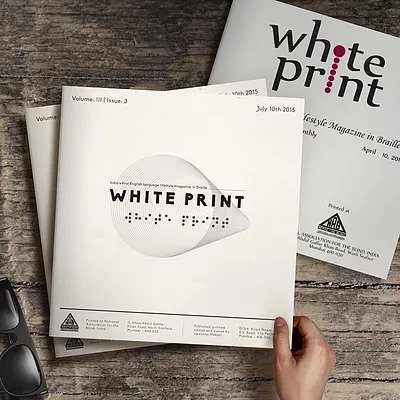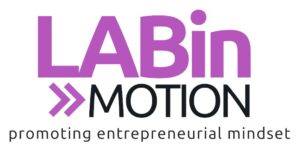Each time, she posts an image or a video of her debut story book for children on social media platforms, a description follows: “I’m wearing a white kurta, my hair is tied, and I’ve worn a silver necklace” or “I’m wearing a silver ring. I flip through some pages of the book and then focus on the colouring page at the end of the book!”
Most of us would think this superfluous, but it makes a world of the difference to those it is meant for – the visually impaired.

Meet Upasana Makati, the founder and publisher of White Print, India’s first English lifestyle magazine in Braille.
Printed at The National Association for the Blind (NAB) in Mumbai, the 64-page-magazine comprises inspiring stories of the common man, review of audio books, gadgets, travel and hospitality, short stories and food related columns. It also news of politics, and art and culture from across the globe.
Founded in May 2013, White Print completed eight years this May. Eight years of sharing words in the dotted script with its special readers across the country, of breaking one myth at a time. Eight years of sowing seeds of inclusion in the minds of children, adults, of struggling to keep the ship afloat!
As a startup founder, Makati shares lessons from her journey so far, the challenges of Covid-19 crisis, and her take on what it means to be an entrepreneur whose startup is built for a social cause but is not charitable and new opportunities.
Turning A Midnight Thought Into A Vision for Visually Impaired
White Print was born out of a sudden thought, and a worry.
Makati personally loves her newspaper and enjoys flipping through the pages even if she does not have much time. The idea of picking up a newspaper with her cup of tea is a routine for her, and it was in the middle of one night back in 2013 that she wondered: “What do the visually impaired start their day with?”
“I do not know why that thought came to me. I had nobody who was blind in my family, close network of friends, distant relatives or neighbours. Once the thought came to my mind, I googled it immediately and even spoke to a few friends at 1 a.m. to asking them questions like ‘do you know what is available in braille’, etc,” she recalls.
That sudden question did not leave Makati. She then decided to visit the NAB’s office in Mumbai to find out and take an idea that had come forward. “I asked the then director that if I started a magazine for the visually impaired, would he allow me to use their press to print my magazine if I paid for it. At this, he asked me if I had institutional backing or if the government or a corporate sponsor was supporting them,” says Makati who was 23 then.
Makati went back home, did some research and then approached the NAB again, requesting it to connect her to a few visually impaired people. “By connecting with them, I wanted to understand why something like this had not existed before and if I started the magazine, would they be interested in reading it,” she says.

After three months of research, Makati quit her job and decided to dedicate herself to launching a lifestyle Braille magazine for the visually impaired. She started the legal process for it which took around eight long months. Once she got a title, she got three months to start the first edition of the magazine. “That’s how it all started, there was no inspiration, it was just a thought. I was so convinced that something like this was needed to be present in a country like India,” says Makati.
Priced at Rs 30 per copy since the beginning, White Print empowers the visually impaired to read themselves without depending on audio media or anyone else reading it out to them.
“Our readers have been our biggest support system. I remember one reader wrote to us that she feels empowered and independent because being able to read the magazine herself, she is able to share new information with her family and friends from time to time. It is certainly the most satisfying feeling when we hear such wonderful things from our readers,” says Makati.
A Social Cause, not Charity
The magazine is a for-profit venture, paid for through subscribers and corporate advertisements.
“In our society, disability is always paralleled with charity, and I wanted to break that notion. When I spoke to visually impaired people in an attempt to know my target audience, I realised that they did not want to be treated with pity but were excited at the idea of getting a monthly magazine that they can read themselves. That is when I decided that I will launch the magazine as a commercial venture,” says Makati.
The fact that Makati decided that her magazine is going to be for profit has kept her challenges of funding alive since the launch of her venture.
The magazine did pioneer a way for Braille advertising, but it was difficult to convince corporates to advertise with White Print as the concept was non-existent in India. However, Makati did find her share of success and managed to get some sponsored content. In the past eight years, corporates such as Coca-Cola India, Raymond, Vodafone Tata Group, Vodafone, Aircel and Mahindra, Fevicol, the Raymond group, Yash Raj Films among others have collaborated with White Print.
A bootstrapped venture so far, the biggest hurdle White Print still faces, is funding. “I feel tech startups are way more funded than impact driven startups. We want corporates to take out the advertising budget from their marketing budget, and not their CSR budget and still face the challenge of convincing them. It remains the biggest obstacle for us. I have not been able to hire anybody yet, it is tough but that is what makes it very interesting for me,” says Makati.
New Beginnings
Through the years Makati has come up with certain other products for the community.
In 2016, she launched Tactabet – a one-of-its-kind Braille – Tactile Alphabet book for children in both English and Hindi. The alphabet books enable integrated and fun learning for both – visually impaired kids and those with low vision. “The dismal quality of Braille printing has been a crucial topic of discussion. With Tactabet, we have used Poly-Braille technology that facilitates the permanent nature of the dots and the tactile outlines of images,” she says.
Post Tactabet, Makati ventured into children’s literature in December 2018 with Look Out, Look Within – an illustrated storybook on inclusion. Created in multiple formats – Braille, print, sign language and as an audiobook, it celebrates the friendship of two little girls, both wonderful and special in their very own right. Mia is unable to see the world with her eyes but explores it with her super senses of being able to touch, hear, feel and smell. Anya, her best friend, enjoys learning about the world in an amusing and different way thanks to Mia.
There are so many people with blindness, but we hardly see them in libraries, parks or bookstores, notes Makati. “I realised that there is a big problem. Our bookstores are not accessible so even if blind persons know of a bookstore but if it does not have books for them in Braille, they will not find it of any use or visit the bookstore. For the same reason we don’t see them around because they have no ways of inclusion. That’s when we decided to venture into Children literature and talk about stories that promote inclusion and diversity. The idea is to mould young minds so that when they grow up, they make a more inclusive society, hopefully,” she adds.
During the lockdown in 2020, Makati launched an ebook called Flowers for Sunaina; in an attempt to help children enjoy and embrace the diversity all around.
In February 2021, she turned writer with her debut book “Run Saba, Run!” Illustrated by Subodhini Lakhi, the book is available in print and Braille.
“It is my debut as an author and is written with an attempt to break myths surrounding sports and persons with blindness. I wanted to take the opportunity to share the many stories and personal experiences that my readers and subscribers shared with me, through story books for kids. All our books have been promoting diversity and inclusion in the minds of young kids,” says Makati, who self-publishes her books.
“There are not many writers, authors or publishing houses focusing on literature that are promoting inclusion and diversity. I feel we do that through our books and through our stories beautifully,” she adds.
Covid–19 Challenges
The Covid -19 pandemic has been painful in every way for the Mumbai-based entrepreneur, as it has only made her problems expand.
The pandemic has had a harsh impact on the magazine. “The whirlwind of emotions, the suffering, and the helplessness is evidently playing its part in all businesses. The magazine isn’t being dispatched. We have been on hold since April because of the lockdown. We have lost some corporate sponsorship and hence now print only 150 copies compared to 300 earlier. Advertising contracts aren’t renewed and hence it has been quite tough. The promotion/sales of my latest book ‘Run Saba, Run!’ are on hold too.
“As a founder, the worry hits the roof each day,” says Makati.
No matter how tough it is, “the love and support of my readers keeps me going,” Makati notes.





